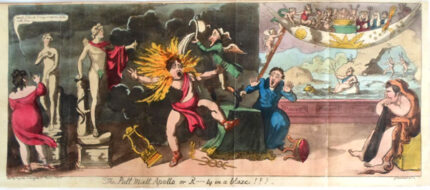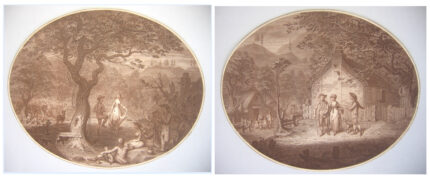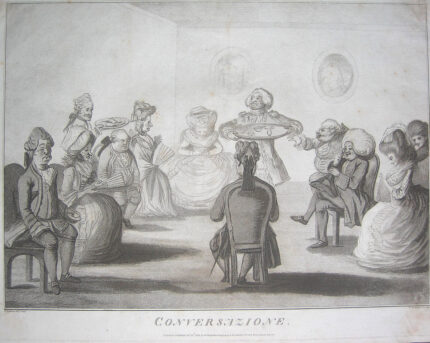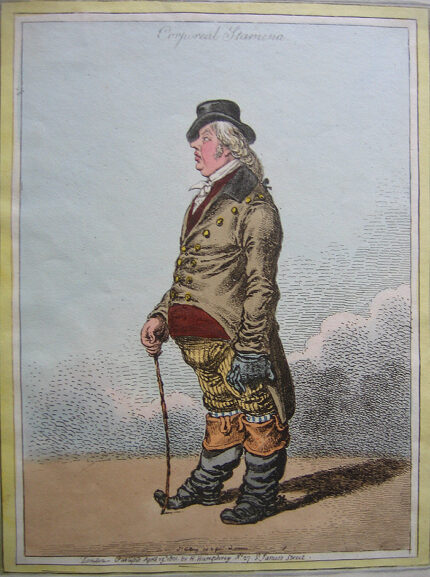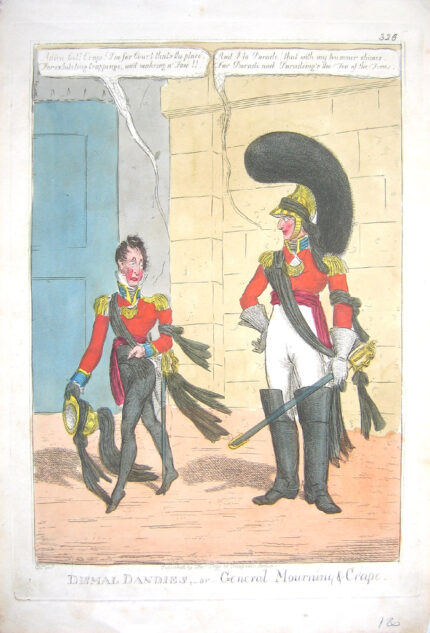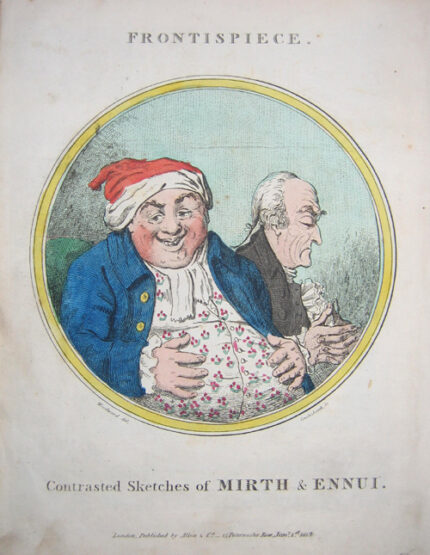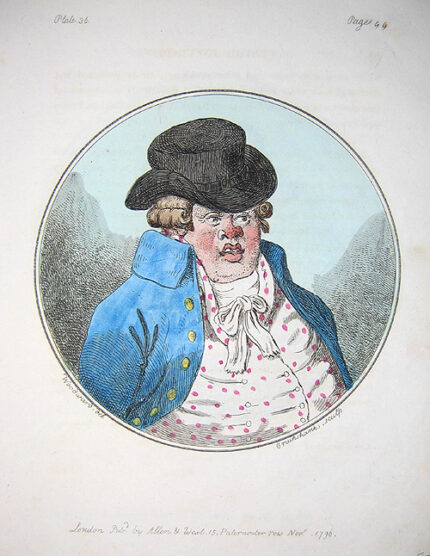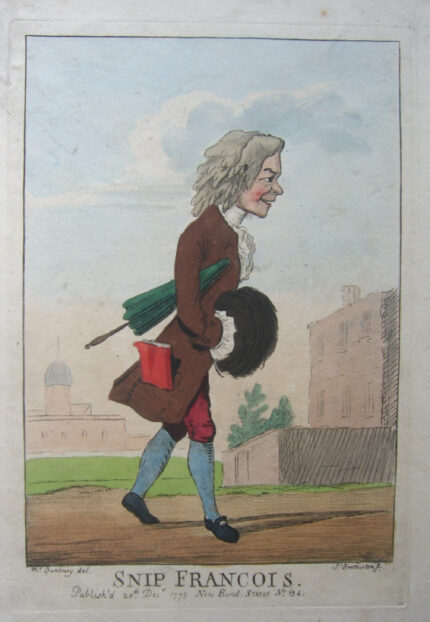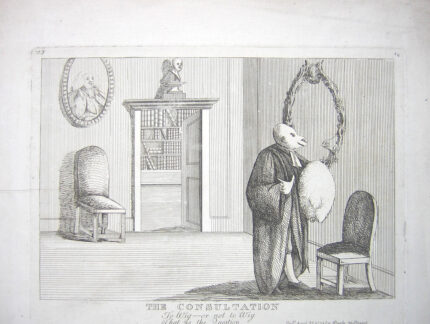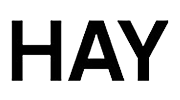The Political Medley or Things as they were in June 1812
£420.00
George Cruikshank The Political Medley or Things as they were in June 1812. London, M. Jones July 1st. 1812, The ScourgeEtchingOriginal hand colouring215 x 495 mmTraces of old folds as issued
George Cruikshank
The Political Medley or Things as they were in June 1812.
London, M. Jones July 1st. 1812, The Scourge
Etching
Original hand colouring
215 x 495 mm
Traces of old folds as issued
£420
An intricate design, the chief feature being a fantastic pavilion (right), directed to the left, whose (open) right side abuts on a precipice inscribed ‘Gulph of Dispair’. In large letters above the front are the words ‘He[rtford] Nursery’, below which hangs a semicircular placard: ‘Wanted an Upper Servant he must do as his Mistress bids him. A Clever active fellow will meet with great Encouragement—Also Wanted several Journeymen Cabinet Makers, great wages—and little to do—Enquire Within.’ Inside, Lady Hertford is seated regally, dandling the Regent on her knee; one foot rests on the little infant’s commode which forms her foot-stool, and from which she has picked up the Prince. This commode is in the form of a throne, with a crown, the Prince’s feathers, and initials ‘G.PR.’ The Prince, an absurd mannikin wearing the insignia of the Garter, puts an arm round her neck, holding up a coral and bells; in his left hand is a bottle of ‘Curaçoa’. Yarmouth approaches from behind with a punch-bowl. On Lady Hertford’s right is a table draped with green cloth and covered with blocks of different dimensions inscribed respectively: ‘Liverpools Ash’, ‘Moiras Heart of Oak’, ‘Grenvilles Log Wood’, ‘Rosewood’ [an allusion to George Rose], ‘Castlereaghs Middleburg Yew’ [an allusion to the calamities of Walcheren, see No. 11364, &c.]. She looks down at the trustfully upturned face of the Prince, pointing to her table, and saying: "Really My Love it is impossible to make a Cabinet out of such discordant Materials." Lord Hertford, with antlers, who is grovelling on the floor behind his wife, looks up to say: "Keep him at play My Dear or we are Lost." Lady Hertford wears a crown-like coronet from which curves a tall ostrich feather. From the roof of this ‘Nursery’ dangles an extinguisher or fool’s cap decorated with bells and inscribed with the Prince’s motto, ‘Ich Dien’; to this a birch-rod is tied. By the Prince’s empty chair is an open book: ‘Songs for the Nursery Georgee Porgee Ride in a Coachee Poach . . ‘ The two posts which support the front of the pavilion are fantastically and symmetrically decorated with carved figures: a terminal figure, with a bearded satyr’s head, supports a drink-blotched infant Bacchus on whose shoulders stands an almost naked nymph holding out the drapery which decks the sides of the structure. Just inside the pavilion, and facing its right end, stands a handsome, fashionably dressed man (Stuart Wortley) lifting above his head a massive club inscribed ‘Adress of the House of Commons’; with this he has just hurled Lord Liverpool head-first into the ‘Gulph of Dispair’. The falling Minister clutches a paper inscribed ‘L . . . Pool’ and says: "D—n the disgrace I’ll be prim [sic] yet." Clinging to the edge of the adjacent precipice is Lord Melville, wearing Highland dress, one hand on the dais of the pavilion, the other holding a broken anchor inscribed ‘First Lord of the Admritaty’ [sic]. He cries: "Wha Want’s Me [see No. 11880, &c.]." The ‘gulph’ recedes into the background behind the pavilion on the right of the design. Half-way down it, on a grassy ledge, sits Queen Charlotte, a grotesque figure, crowned, and taking snuff, a large jar of ‘Princes Mixture’ beside her (cf. No. 12066). Against her ledge rests a ladder up which climbs Lord Eldon, wearing his Chancellor’s wig and gown; he looks down at Castlereagh whose head and shoulders appear in the lower right corner of the design, and who looks up, grinning. Eldon holds out an encouraging arm to him, saying, "Come along my Lads this is the way to get in again." The Queen says: "Never fear I’ll protect you." Behind (right), the precipice ascends to a higher level; on the summit is a well-head, its open shaft descending into the ‘gulph’. A skeleton (Death), wearing breeches, turning the windlass, has drawn up a bucket, inscribed ‘Grey Mud’; in this sits Grey, delightedly saying, "Here I go Up Up Up"; in the descending bucket is a large rose (George Rose), saying, "Here I go down down downy." On the left half of the plate are isolated figures and groups, skilfully merged in the design. On the extreme left is an open sentry-box, in which Sheridan stands asleep with folded arms, leaning against the side. He wears Harlequin dress (cf. No. 9916) and clasps a bottle of ‘Sherry’. Grenville, with gouty legs and enormous posterior, marches (left to right) towards Moira, who stands full-face, stiff and impassive, beating a (broken) drum inscribed ‘G P R’. The right legs of the two men are shackled together by a heavy chain inscribed ‘Necessity’. Moira says: "I must Halt." Between and behind Sheridan and Grenville, a ragged John Bull, with empty and torn pocket, sits on a hillock, facing two ragged and emaciated children who exclaim "give us bread." He answers: "I have no Bread to give you—nothing but a few Mushrooms." Meanwhile, McMahon, bestriding a small gaping dragon inscribed ‘Privy Purse’ [see No. 11874] is stealing from him a paper inscribed ‘2,000 Pr A’. Behind and on the right of McMahon is Canning, kicking along a golden ball inscribed ‘Popularity’. Between him and the left corner of the ‘nursery’ stands Wellesley wearing a jewelled turban and grotesque boots with military uniform. While holding up a banner he lifts the lid, inscribed ‘Catholic Restrictions’, of a large box inscribed ‘Ireland’, from which flames rise high into the air, terminating in dense clouds and darts of lightning, inscribed ‘Dreadful Private Anamosites’, which have broken the tall shaft of the banner which is inscribed ‘Wellesley Mahratta War’. Frightful creatures emerge from the box: a grotesque man wearing a papal tiara and holding a large dagger which drips blood is inscribed ‘Superstition’; beside him are serpents, barbed spears, and a crowned skull. Wellesley stands on a paper: ‘Liberty of ye Press’. In the foreground the Duke of Atholl kneels on a cushion in front of the pavilion, proffering a large disk or coin with the three running legs which are the emblem of the Isle of Man and the inscription ‘My Services a Manks Half-penny’. A long mantle decorated with Masonic symbols hangs from his shoulders, partly covering a bundle inscribed ‘70,000 Grant to ye D of At[holl]’. He wears a Scots cap, with bag-wig, breeches, and tartan stockings. Behind this left half of the design is a landscape background with tiny but expressive figures. A road ascends (right to left) past a rocky mound inscribed ‘Treasury’, in which there is an open door. Plunderers are about to enter, led by Eldon holding a dark lantern and followed by three others: ‘Placem[an]’ resembles McMahon, a ‘Pensi[oner]’ has the grotesque nose of Curtis, another wears spectacles which suggest the Marquis of Buckingham. A fourth walks off carrying a sack inscribed ‘Pension’. On the top of the mound grow trees, a weeping willow and a decayed oak with a noose hanging from a withered branch. At the top of the hill a coach, the ‘Britannia High Flyer’, has left the road and the four horses are plunging to destruction down a steep craggy incline. The back wheels have broken off and the guard lies on the ground as if dead, his blunderbuss and horn beside him. The disaster is due to the Regent, the coachman, who is kissing Lady Hertford, to whom he has given the reins. She wears a crown and feather as in her ‘Nursery’. John Bull (not named), the outside passenger, is about to fall headlong; a sinister grinning face looks from the coach window. Beside the coach is a triple sign-post; one arm, inscribed ‘Rd to Ruin’ [cf. No. 11862], points down the fatal hill; one, with a rope dangling from it, has a finger pointing at the Regent.



